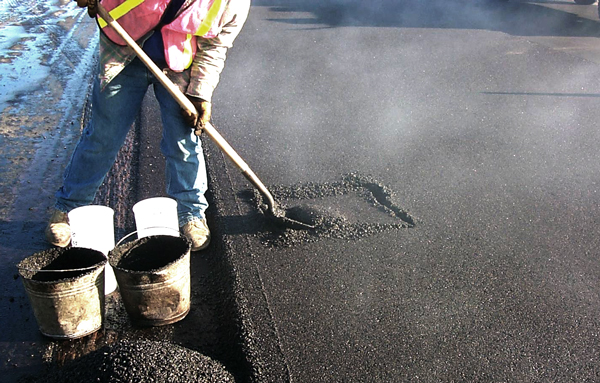Hot Mix Asphalt: The Structure for Safe and Secure Angled Parking Lots
Hot Mix Asphalt: The Structure for Safe and Secure Angled Parking Lots
Blog Article
Opening the Keys of Warm Mix Asphalt Technology
Discovering the midsts of hot mix asphalt technology uncovers a globe where thorough procedures and specific solutions merge to form our roadways and framework. The blend of binders, accumulations, and fillers isn't merely a construction task but a strategic orchestration of durability and efficiency. As we peer right into the detailed dancing of elements, a tapestry of durability and sustainability unfolds. But what exists under this surface area of asphaltic proficiency, and what keys wait to be revealed in the realm of paving technologies?
Value of Hot Mix Asphalt
Warm Mix Asphalt plays an essential duty in contemporary framework development as a result of its sturdiness and cost-effectiveness. As one of the most typically made use of paving product for roadways, highways, and car park lots, Warm Mix Asphalt provides a variety of benefits that add to its relevance in building jobs. One key advantage is its capacity to withstand rush hour loads and severe climate problems, offering a resilient and reliable surface area for transportation networks. Furthermore, Warm Mix Asphalt is cost-efficient in both initial construction and long-lasting upkeep, making it a recommended selection for many facilities jobs.
The sturdiness of Hot Mix Asphalt comes from its composition, which includes aggregates, binder, and filler materials that are carefully selected and mixed to fulfill particular performance requirements. This precise combination causes a solid and adaptable pavement that can endure constant usage without considerable deterioration. Warm Mix Asphalt is 100% recyclable, more improving its sustainability and environmental advantages. Generally, the value of Hot Mix Asphalt in framework growth can not be downplayed, as it remains to be a keystone of contemporary construction techniques.
Elements of Asphalt Mixes
The structure of asphalt blends is composed of meticulously selected aggregates, binder, and filler materials that are vital for attaining particular performance demands. Accumulations are the key part of asphalt mixes, offering stamina and stability. The binder, normally asphalt or asphalt concrete, holds the aggregates together and offers versatility and toughness to the mix.
The mix and percentage of these parts play a substantial duty in determining the quality and performance of the asphalt mix. Engineers carefully develop the mix to satisfy particular demands, thinking about elements like web traffic volume, environment problems, and pavement lifespan. Proper selection and balancing of accumulations, binder, and fillers are essential for developing sturdy, durable asphalt sidewalks.
Mixing and Production Techniques
:max_bytes(150000):strip_icc()/asphalt-worker-134249388-58cdf96f5f9b581d723f2f33.jpg)
When the accumulations are chosen, the binder, commonly asphalt concrete, is included in bind the products with each other. The binder's top quality and amount significantly influence the mix's stamina, resistance, and flexibility to environmental elements. Additionally, fillers like hydrated lime or Rose city concrete might be integrated to improve particular qualities of the asphalt mix, such as its workability or moisture resistance.
During manufacturing, the accumulations and binder are heated why not look here up, usually between 250-325 ° F(121-163 ° C ), to facilitate blending and make certain appropriate finishing of the aggregates. The blending procedure should be extensive to achieve an uniform blend that promotes the desired efficiency attributes of the asphalt. Various strategies, such as set mixing or drum blending, are used to achieve consistent and high-quality asphalt mixes for construction tasks.
Elements Influencing Asphalt Performance
Factors affecting asphalt performance incorporate a variety of variables that impact the longevity, durability, and total high quality of asphalt sidewalks. One crucial factor is the high quality of materials utilized in the asphalt mix. The kind and source of accumulations, the binder quality, and the ingredients all play a significant duty in determining the efficiency of the asphalt sidewalk. The gradation of accumulations is essential as it influences the mix's resistance, security, and workability to rutting and splitting.

Layout factors to consider, such as pavement thickness and drainage, are vital in making certain the lasting performance of the asphalt pavement. By carefully taking into consideration these engineers, service providers and aspects can maximize asphalt efficiency and improve the service life of pavements.
Sustainable Practices in Asphalt Technology

Additionally, the development of warm-mix asphalt (WMA) technologies has obtained grip in recent times. WMA enables the production and placement of asphalt blends at reduced temperatures compared to typical hot-mix asphalt, causing minimized energy consumption and greenhouse gas exhausts. In addition, using porous asphalt mixes can aid alleviate stormwater drainage problems by allowing water to penetrate with the pavement and right into the article ground, advertising natural water filtration and reenergize processes. By implementing these lasting practices, the asphalt sector can contribute to constructing an extra resistant and ecologically pleasant facilities network.
Final Thought
To conclude, hot mix asphalt innovation plays a crucial role in contemporary framework development because of its longevity and cost-effectiveness. By thoroughly balancing elements, using correct blending techniques, and considering different aspects, designers can develop high-grade asphalt blends that hold up against heavy traffic loads and harsh climate condition. Embracing sustainable practices, such as using warm-mix technologies and recycled products, better boosts the ecological friendliness of asphalt technology.
Mixing and production techniques in warm mix asphalt innovation entail the exact combination and handling of accumulations, binder, and fillers to create a high-performance and durable asphalt mix.Variables influencing asphalt efficiency include a range of variables that impact the sturdiness, long life, and general quality of More about the author asphalt sidewalks. Lasting practices in asphalt innovation incorporate various initiatives intended at decreasing the environmental influence of asphalt production and paving procedures. By including reclaimed asphalt sidewalk (RAP) and recycled asphalt roof shingles (RAS) into brand-new asphalt mixes, the industry can considerably lower the consumption of raw materials and power, while also decreasing landfill waste.
WMA allows for the production and positioning of asphalt blends at reduced temperature levels compared to standard hot-mix asphalt, resulting in decreased energy consumption and greenhouse gas emissions.
Report this page